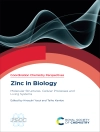Metal Nano 3D Superlattices
Unique view on producing metal nano 3D superlattices by differing their morphologies, crystalline structures, chemical, and physical properties
After presenting an overview on the various factors involved in producing metal 3D superlattices called supracrystals by differing their morphologies, crystalline structures, chemical, physical, and intrinsic properties, Metal Nano 3D Superlattices: Synthesis, Properties, and Applications reveals the existence of new materials with unexpected properties. Readers will gain insight into the various approaches on the production and on the specific properties of nanocrystals self-assembled in 3D superlattices also called colloidal crystals, supra or super crystals. These properties open up new avenues of research and potentially aiding in major progress. Overall, the work reviews the progress of and gives perspective on assembled nanocrystals, with a concentrated focus on self-assemblies of metal nanocrystals.
Sample topics covered by the highly qualified and internationally awarded author include:
- Syntheses of nanocrystals with low size distribution.
- The wide variety of self-assembled nanocrystals in 3D superlattices strongly depends on an impressive number of parameters.
- The intrinsic chemical and physical properties of 3D superlattices of nanocrystals opens the way to the discovery of unexpected properties. This concerns growth processes, coherent breathing of in 3D superlattices, electron transport through thick assemblies, etc.
- A strong analogy between atomic crystals and 3D superlattices of nanocrystals emerge: incompressible nanocrystals and coating agents act as mechanical springs holding together the nanocrystals and replace respectively, in atomic crystals, atoms and atomic bonds.
- The intrinsic chemical and physical properties of nanocrystals and their assemblies depend on their crystalline structures called nanocrystallinity.
- Collective properties due to dipolar interactions between nanocrystals are pointed out.
- Water soluble suprastructures act as efficient universal nanoheaters. In addition, reconstruction near the cytoplasmic membrane in tumor cells of nanocrystal self-assemblies takes place opening various biomedical applications.
- The physical (optical, magnetic, electronic, vibrational) properties of isolated nanocrystals remain present in addition to the intrinsic and collective properties. This allows to benefit from the unique properties of nanocrystals while avoiding their potential size-related risks in future applications.
Metal Nano 3D Superlattices offers a deep dive into their synthesis, chemical and physical properties, and applications and is an essential resource for inorganic chemists, materials scientists, physical chemists, surface chemists, and medicinal chemists conducting research related to or involved in the practical application of the topics covered within.
表中的内容
1. Analogy between atomic crystals and supracrystals
2. Nanocrystals Syntheses
3. Chemical and Physical properties of metal nanocrystals differing by their nanocrystallinities
4. Supracrystal growth processes.
5. Collective properties (optical, magnetic, vibrational) due to dipolar interactions of 2D and 3D supracrystals
6. Intrinsic properties of supracrystals
7. Elastic properties of supracrystals
8. 3D self assemblies of supracrystals in aqueous solution
9. Encapsulation of nanocrystals into liposomes
10. Potential application of such assemblies
关于作者
Marie-Paule Pileni is a Distinguished Professor at Sorbonne University and Senior Researcher in Nuclear and Environmental Center, France. She is a member (1999- at present) and chair (2004-2010) of Institut Universitaire de France, IUF, which favors the development of high-quality research and interdisciplinary projects among French universities. Over her career, she has been recognized by a number of international awards, including the Emilia Valori Award from the French Academy of Sciences, the Descartes-Huygens Prize from the Royal Netherlands Academy of Arts and Sciences, the Langmuir Lectureship Award from the American Chemical Society, the Pierre Sue award from the French Chemical Society, an Alexander von Humboldt Foundation award from Germany, a Catalan- Sabatier Lectureship award from the Royal Society of Chemistry of Spain, a Lecture Award from the Japanese Chemical Society, and Doctor Honoris Causa, from Chalmers University, Sweden.












